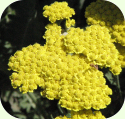Yarrow
Yarrow is an herbaceous perennial that is a member
of the sunflower family.
Other Names: Arrowroot, Bad Man's Plaything,
Bloodwort, Carpenter's Weed, Death Flower, Devil's
Nettle, Eerie, Field Hops, Gearwe, Hundred Leaved
Grass, Knight's Milefoil, Knyghten, Milefolium,
Milfoil, Millefoil, Noble Yarrow, Nosebleed, Old
Man's Mustard, Old Man's Pepper, Sanguinary, Seven
Year's Love, Snake's Grass, Soldier, Soldier's
Woundwort, Stanchweed, Thousand Seal, Woundwort,
Yarroway, Yerw, Milfoil, Western Yarrow, Common
Yarrow, Thousand Weed, Nose Bleed,
Scientific Classification:
Kingdom: Plantae
Order: Asterales
Family: Asteraceae
Genus: Achillea
|
|

Yarrow |
|
Descriptions: Yarrow has feathery, fern-like
foliage, with flattened flower clusters that come
in a variety of colors.
Size: Yarrow can grow up to 3 feet tall.
Symbolism: Yarrow represents both healing
and inspiration. Many people give yarrow flowers
to symbolize their concern for the recipientís
well-being.
Grow Details: Yarrow is very easy to grow,
established plants are drought tolerant, and many
consider yarrow invasive.
Grow Details
Soil Type: Well
Drained Soil - Sandy Preferred
Soil PH: PH 6.0 to 6.5.
Water: Standard - Drought Tolerant
Light: Full Sun
Grow Zone: 3, 4, 5, 6, 7, 8
|
|
Characteristics
Height: Yarrow grows from 2 to 3
feet tall.
Flower Colors: Yellow, White, Pink
or Red
Propagation: Yarrow can be invasive
and self-propagates
Division/Transplants: Divide Every
Other Year
Blooming Period: Spring to Summer
|
Type: Perennial
Herbal Remedy Properties: Yarrow is thought
to have the following medicinal properties as
a diaphoretic, astringent, tonic, stimulant and
mild aromatic. Yarrow is thought to be a powerful
'healing herb used topically for wounds, cuts
and abrasions. he genus name Achillea is derived
from mythical Greek character, Achilles, who reportedly
carried it with his army to treat battle wounds.
Native Area: Yarrow is native to Europe
and naturalized through North America.
Other:
|
